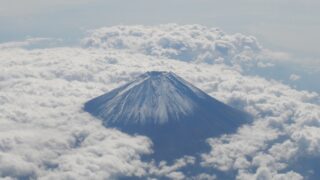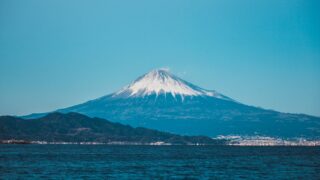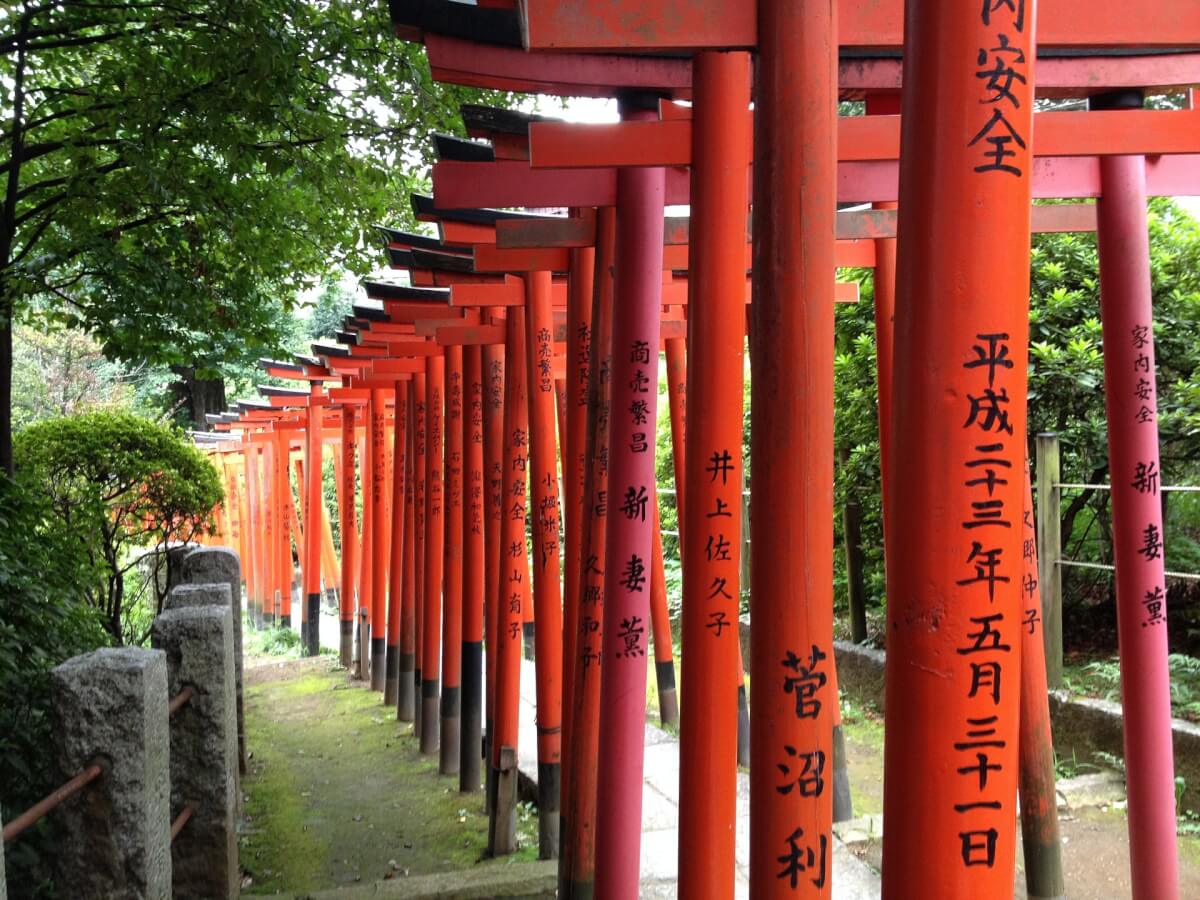When you are in Japan or planning to visit Japan, you have probably thought about climbing Mt. Fuji. Mt. Fuji is the tallest mountain in Japan (3,776m). It is one of the most iconic mountains in the world for its nearly symmetrical shape and snow-capped summit in winter. Every year, Mt. Fuji attracts thousands of mountain climbers from all over the world during the official climbing season (early July to early September).
But, did you know that the bottom half of Mt. Fuji also offers historical heritage and dynamic nature? Following the traditional pilgrim route is a spiritual, relaxing experience. The trails at the foot of the mountain are easier to climb and the hiking season is longer than the top half of the mountain. Particularly in spring, you can see beautiful flowers and blossoms such as the sakura (cherry blossom) along the way!
In this article, we provide a guide to hiking Mt. Fuji, from the bottom to the top.
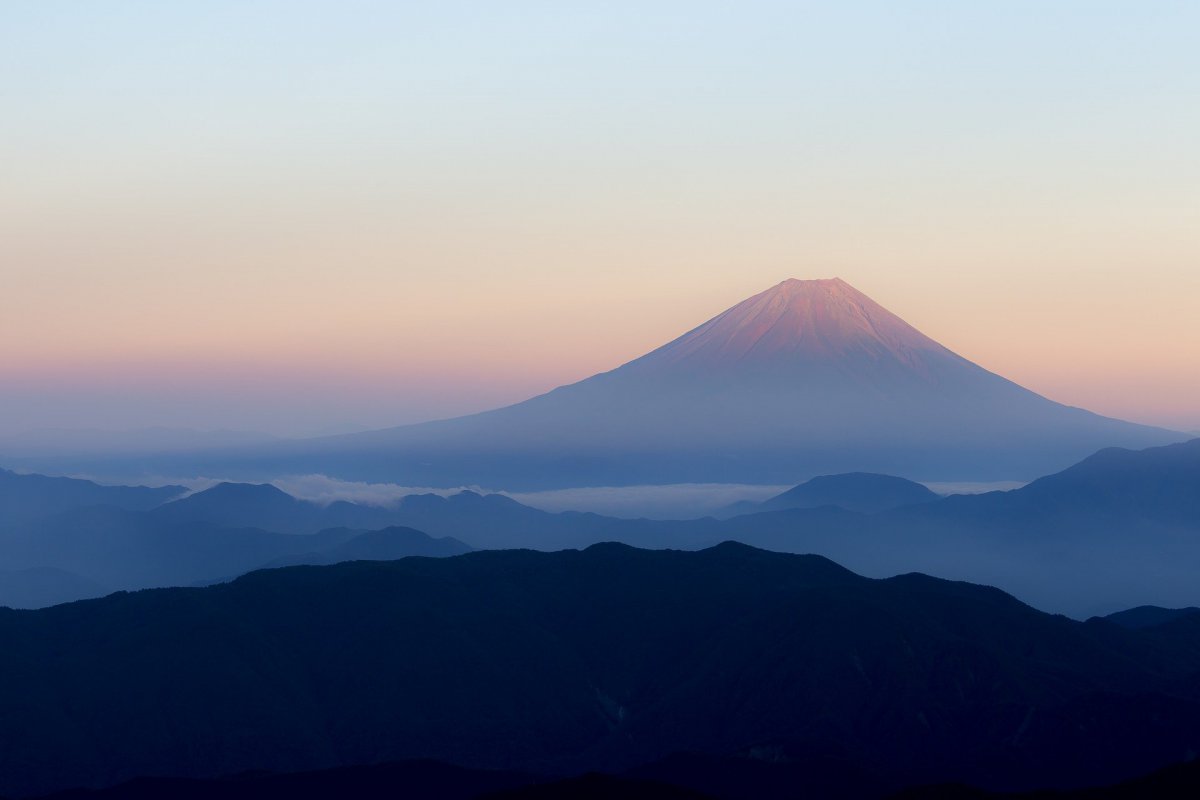
Where is Mt. Fuji located?

Mt. Fuji straddles the boundary of Yamanashi and Shizuoka Prefectures of central Honshu, the main island of Japan. It is located about 100 km west of the Tokyo metropolitan area and on clear days is visible from Tokyo! When you stand on the observatory decks for example the red-white Tokyo Tower and Japan’s tallest structure TOKYO SKYTREE, you can see Mt. Fuji when it is sunny!
When is a good time to climb Mt. Fuji?
In 2025, the climbing season will start on the first week of July and will be closed in early September
The official climbing season of Mt. Fuji generally lasts from early July to the beginning of September, when the weather is relatively mild, huts are operating, and public transportation runs frequently. Mt. Fuji is especially crowded on weekends from mid-July to late August, with a peak in Obon Week, the summer holiday season. It is not unusual to see continuous lines of people climbing, queuing to reach the summit! We recommend trying to avoid climbing Mount Fuji during Obon Week if you prefer a quieter time.

Climbing Mount Fuji off-season is not allowed
While some experienced hikers choose to climb Mt. Fuji outside of the climbing season, we highly discourage you to do so. Outside of the climbing season, the huts are closed and the weather conditions can be extreme. Even if there is no snow on the top of Mt. Fuji, the temperature can drop far below zero from October onwards.
If you travel to Mt. Fuji off-season, the hiking season lasts longer from the lower half of Mt. Fuji. Arguably the best time to visit is in spring when you can enjoy dynamic nature with sakura and other flowers in full bloom. To get the most out of your experience and travel safely, we recommend you join a tour. The guide will teach you all about the historical and cultural heritage of Mt. Fuji!
Trails of Mt Fuji

The first thing you should know is there are four main trails leading to the top of Mt. Fuji. Each trail departs from a ‘Fifth Station’ and they vary in distance to the summit, steepness, and available facilities. They are also marked in their own color on the map and signboards on the way. Depending on your climbing experiences and preferences, you can choose at which station to start your ascent. The four trails to the summit of Mount Fuji are:
- Yoshida Trail
- Subashiri Trail
- Gotemba Trail
- Fujinomiya Trail
1. Yoshida Trail
Starting point: Fuji Subaru Line 5th station (Yamanashi Prefecture)
Ascent: 5-7 hours
Descent: 3-5 hours
Color: yellow
Most of the hikers take this route on the north side to ascend the mountain because it is considered the easiest and you can see the sunrise from here. Plus you have easy access from Tokyo by public transportation. At Fuji Subaru Line Gogōme, also known as Yoshidaguchi 5th Station or Kawaguchiko 5th Station, there are a few stores and some eateries. It is also the last station to gear up before making your way to the summit. Along the trail, several first-aid points are located (at 5th, 7th, and 8th stations). About 15 huts can be found along the trail where you can buy some food and drinks and use a toilet for ¥100. If you want to stay at the mountain huts, you should make a timely reservation, especially during Obon week!
2. Subashiri Trail
Starting point: Subashiri 5th Station (Shizuoka Prefecture)
Ascent: 5-8 hours
Descent: 3-5 hours
Color: red
The first section of the Subashiri Trail is below the tree line and leads through the forest that protects the climbers from strong sunshine or wind. It is the second easiest to access by public transportation from Tokyo. The Subashiri Trail meets the Yoshida Trail around 8th station so from the 8th station it can get quite crowded. There are two small stores at the 5th station, no first-aid office, and about seven huts with toilets along the trail.
3. Gotemba Trail
Starting point: Gotemba 5th Station (Shizuoka prefecture)
Ascent: 7-10 hours
Descent: 3-6 hours
Color: green
This is the lowest located 5th station and its gradient is the least steep of all trails, therefore, it is also the longest way to the summit. The Gotemba Trail is physically the hardest route, the advantage of this is that it is also the least crowded amongst the four trails. There is a store at 5th station and about three huts along the trail, but there is no first-aid point along the route.
4. Fujinomiya Trail
Starting point: Fujinomiya 5th Station (Shizuoka prefecture)
Ascent: 4-7 hours
Descent: 2-4 hours
Color: Blue
The second most popular trail, after the Yoshida Trail, starts at the highest 5th station and is the shortest route to the summit. The slopes are rather steep and rockier than other trails. There is a store at 5th station, a first-aid office at 8th station and about 7 huts along the trail.
For more detailed information about climbing Mt. Fuji and the different trails, please visit the official website of Mt. Fuji or this convenient brochure.

Hiking the base of Mt. Fuji
Each trail of Mt. Fuji has 10 different ‘stations’ and you might wonder why the trailhead starts at the fifth station. The first station is located at the foot of the mountain and the 10th station is at the summit. You certainly can start your hike from the first station or even before, from Mt. Fuji Station. In this way, you can appreciate more the nature and historical background of Mt. Fuji. It does add another 3-5 hrs to your trip.
Starting point: Kitaguchi-hongu Fuji Sengen Shrine
Ascent: ~3 hours
Descent: 2 hours
The slopes are relatively gentle here, you will start at the shrine and follow the Yoshida Recreational Footpath to the 1st station. There are historical shrines and remains of old resting places along the way of this traditional pilgrimage route. After a few hours, you will get to Fuji Subaru Line 5th Station, the Yoshida Trailhead. From here you can continue to the top of Mt. Fuji, hike back down, or take a bus. Especially when you do not want to climb Mt. Fuji all the way to the top we highly recommend you walk this trail! To make the most out of your experience join a tour that will take you around the mountainous area.
▶Mt. Fuji Pilgrim Hiking (1st to 5th Station)

Climbing Mt. Fuji overnight
Seeing the sunrise at the top of Mt. Fuji is for many a must-do and most climbers plan their trip so that they arrive between 3 am and 4 am at the top. That is also when it gets super crowded near the top, if possible, aim to reach the peak before 3am. To do so, start climbing Mt. Fuji in the afternoon and catch a few hours of sleep at one of the mountain huts. However, this is quite popular and most huts are booked out over the weekends.
Please note that from 2024, overnight climbing without staying at a hut is not allowed to ensure safety. Trails will be closed from 4 pm to 3 am to those who don’t have a reservation at a hut. Also, you need to pay 2,000-3,000 yen to go through the gate at the entrance of the trails.
But the real magic starts when suddenly a faint strip of red appears out of the pitch-black sky, revealing the horizon. You will hear ‘ohhs’, ‘ahhs’ and ‘sugoii’ everywhere when the sun casts its light over the lakes below, revealing the surroundings of Mt Fuji, the lakes, and the hills. Seeing the sunrise at the top of Mt. Fuji after such an effort is an experience you will never forget!
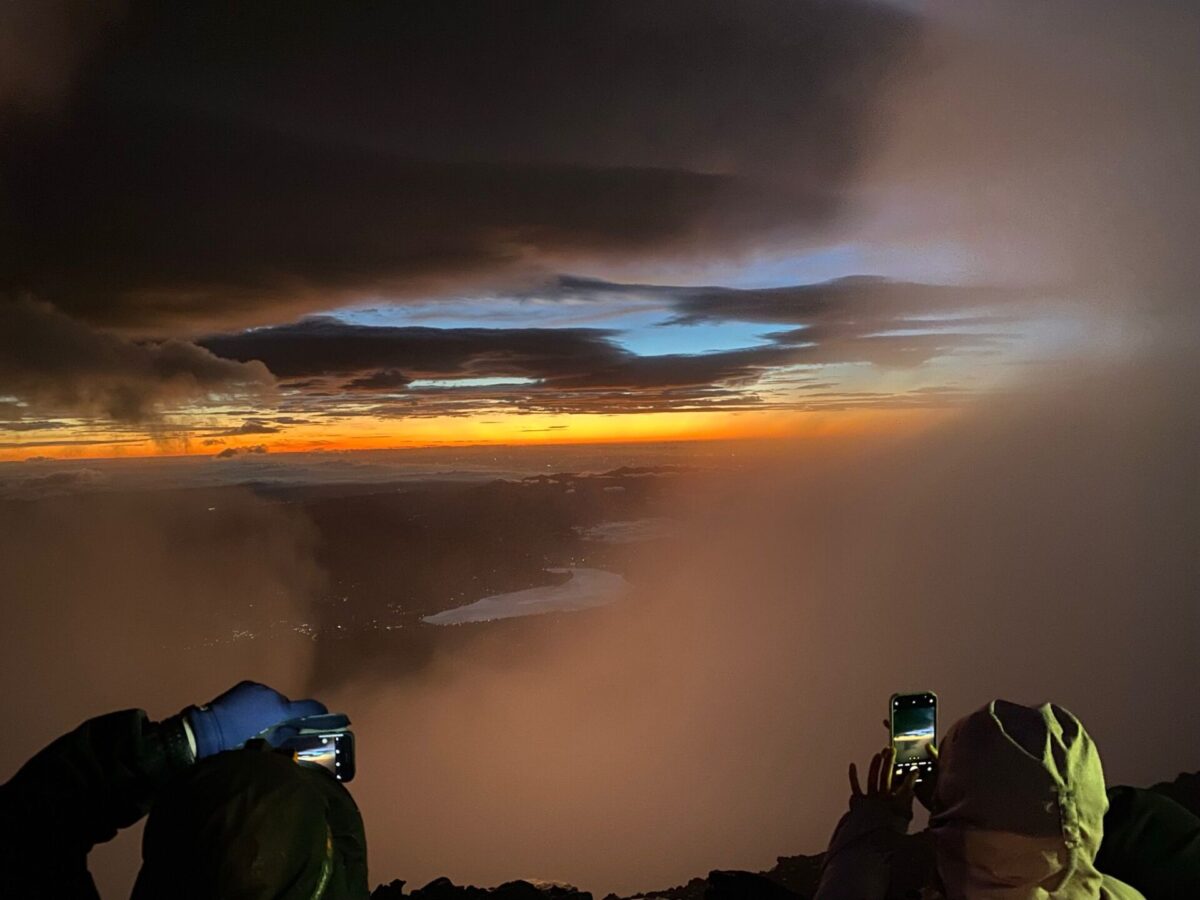
Things to remember before climbing Mt. Fuji
Since Mt. Fuji is a very popular mountain to climb, sometimes people underestimate the difficulty of climbing the mountain. Needless to say, Mt. Fuji is the tallest mountain in Japan and it has some risks that you have to keep in mind. There are some accidents caused every year, so take caution when climbing Mt Fuji! Here are some important things to know to prevent any accidents before climbing Mt Fuji.
- The temperature drops drastically near the top of the mountain. Many people climb Mt. Fuji to see the sunrise from the top, but there can be a 20℃ difference between the bottom and the top of the mountain. Sometimes it even snows in August! Always bring a warm, waterproof jacket, a beanie, and gloves when you climb to the top.
- The weather can change while climbing Mt Fuji. When it’s bad weather with lightning, strong wind, and heavy rain, take shelter at the hut or descend the mountain immediately.
- Always follow the trekking route. There’s always a risk of falling rocks.
- Bring a flashlight or headlamp to prevent accidents when you climb the mountain during the night.
- Mt. Fuji is actually an active volcano. Please check the eruption alert before climbing!
- When you arrive at the 5th station, take a moment to adjust to the altitude before you start climbing.
- It can get super busy when you are near the top of Mount Fuji, if you want to watch the sunrise from the top we recommend 1) taking the Yoshida Trail, 2) aiming to arrive before 3am
Preparation will be needed to climb Mt Fuji to the top safely. If you want to enjoy a pleasant and easy hike as a beginner, take hiking routes for the bottom half of Mt. Fuji!
Make sure to check the official website for the important notice and weather warnings before you go!
How to access Mt. Fuji?
You can go up to the 5th station by car or bus on paved roads. Most people who climb to the top of Mt. Fuji start their ascent from one of the in total four 5th stations which are located on different sides of the mountain. The schedule of public transportation and vehicle restrictions change depending on the climbing season. Please check the official website before your visit!
Tokyo to Mt. Fuji Station
- From Tokyo Station (Tokyo) about 2hrs.
- From Shinjuku Station (Tokyo) it takes about 1h 45min.
Here you can read more about how to get to Mt. Fuji area.

Buses to Fuji Subaru Line 5th Station
- From Fujisan / Kawaguchiko Station (Yamanashi prefecture) about 1h.
- From Shinjuku Station (Tokyo) about 2h 30min by express bus (reservation highly recommended)
Buses to Subashiri 5th Station
- From Gotemba Station (Shizuoka prefecture) about 1h.
Buses to Gotemba 5th Station
- From Gotemba Station (Shizuoka prefecture) is about 40min.
Buses to Fujinomiya 5th Station
- From Shin-Fuji and Fujinomiya Station (Shizuoka prefecture) about 1h25min.
What to bring when climbing Mt. Fuji?

Whether for climbing to the summit or hiking at the lower section, proper equipment is essential to prevent and minimize accidents.
- Climbing shoes
Proper hiking shoes which protect your ankles. Also, walking with trekking poles would be better. - Proper clothes
Choose clothes made of materials that protect you against low temperatures, strong wind, and rain. On the mountain, the weather can suddenly change so always bring rain gear and wear multiple layers of clothes. Even in the hot summer months, the temperature at the top is often just above 0 degrees at sunrise. - Flashlight/headlamp
Even if you are not planning to hike during the night, you may experience delay because of bad weather conditions or your physical condition, so always bring a flashlight or headlamp. - Water and food
Bring approx. 1-2 liters of water and enough snacks. While you can get some (hot) drinks and snacks at the huts along the way it is important to gear up. Especially when you climb the mountain on the trails with few huts along the way. - Cash money
You need cash at the mountain huts to buy food, water, or canned oxygen. Some toilets require money (¥100 to ¥200). Climbers of Mt. Fuji are asked to contribute ¥1,000 per person at collection stations at each trailhead. This money will be used to preserve the trails.
Recommended hotels in Fujikawaguchiko

What do you think about hiking Mt. Fuji? Most people climb to the summit from one of the 5th stations, however, do not miss the lower half of the mountain where you can discover the tradition and history of Mt. Fuji. Especially in spring, when the climbing season of Mount Fuji hasn’t started yet, you can also enjoy many beautiful flowers and blossoms and fresh greens. Even if you have climbed Mt. Fuji before, you will be surprised at what this majestic mountain has to offer at its base. Also, this is a great option for those who do not can or want to make their way to the top, but still want to experience some of the magic Mount Fuji!
For more information, check out our complete guide to Mt. Fuji below!
We hope you will have a great time in the Mount Fuji area. To receive more information about guided tours in Tokyo or other parts of Japan, please visit our website. We hope you have a good time in Japan!
Follow us on Instagram, Twitter or Facebook for more travel inspiration. Or tag us to get featured!
Happy traveling!
Other articles about Mt. Fuji
This post may contain some affiliate links. When you click through and make a purchase we may receive some commission, at no extra costs to you.

